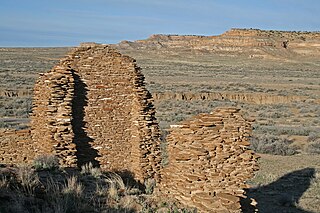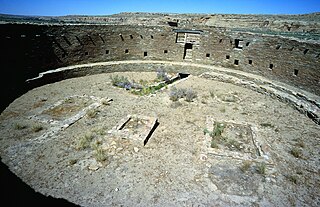
Pueblo Bonito is the largest and best-known great house in Chaco Culture National Historical Park, northern New Mexico. It was built by the Ancestral Puebloans who occupied the structure between AD 828 and 1126.

Salmon Ruins is an ancient Chacoan and Pueblo site located in the northwest corner of New Mexico, USA. Salmon was constructed by migrants from Chaco Canyon around 1090 CE, with 275 to 300 original rooms spread across three stories, an elevated tower kiva in its central portion, and a great kiva in its plaza. Subsequent use by local Middle San Juan people resulted in extensive modifications to the original building, with the reuse of hundreds of rooms, division of many of the original large, Chacoan rooms into smaller rooms, and emplacement of more than 20 small kivas into pueblo rooms and plaza areas. The site was occupied by ancient Ancestral Puebloans until the 1280s, when much of the site was destroyed by fire and abandoned. The pueblo is situated on the north bank of the San Juan River, just to the west of the modern town of Bloomfield, New Mexico, and about 45 miles (72 km) north of Pueblo Bonito in Chaco Canyon. The site was built on the first alluvial terrace above the San Juan River floodplain.
A Timeline of Chacoan history includes Chaco Culture National Historical Park, Aztec Ruins National Monument, Twin Angels Pueblo, Casamero Pueblo, Kin Nizhoni, Pierre's Site, and Halfway House.

Wijiji is a Ancestral Puebloan great house and archaeological site located in Chaco Canyon, in New Mexico, United States.

Una Vida is an archaeological site located in Chaco Canyon, San Juan County, New Mexico, United States. According to tree rings surrounding the site, its construction began around 800 AD, at the same time as Pueblo Bonito, and it is one of the three earliest Chacoan Ancestral Puebloan great houses. Comprising at least two stories and 160 rooms, it shares an arc or D-shaped design with its contemporaries, Peñasco Blanco and Pueblo Bonito, but has a unique "dog leg" addition made necessary by topography. It is located in one of the canyon's major side drainages, near Gallo Wash, and was massively expanded after 930 AD.
Nuevo Alto is an Ancestral Puebloan great house and archaeological site located in Chaco Canyon, in the US state of New Mexico.
Casa Chiquita is a Ancestral Puebloan great house and archaeological site located in Chaco Canyon, northwestern New Mexico, United States.

Chetro Ketl is an Ancestral Puebloan great house and archeological site located in Chaco Culture National Historical Park, New Mexico, United States. Construction on Chetro Ketl began c. 990 and was largely complete by 1075, with significant remodeling occurring in the early and mid-1110s. Following the onset of a severe drought, most Chacoans emigrated from the canyon by 1140; by 1250 Chetro Ketl's last inhabitants had vacated the structure.

Pueblo del Arroyo is an Ancestral Puebloan great house and archaeological site located in Chaco Culture National Historical Park, in New Mexico, United States.

Hungo Pavi is an Ancestral Puebloan great house and archaeological site located in Chaco Canyon, northwestern New Mexico, United States. A set of ruins located just 1 mile (2 km) from the ruins of Una Vida, Hungo Pavi measured 872 feet (266 m) in circumference. Initial explorations revealed 72 ground-level rooms, with structures reaching four stories in height. One large circular kiva has been identified. Its ruins now lie within Chaco Culture National Historical Park.

Pueblo Alto is an Ancestral Puebloan great house and archaeological site located in Chaco Culture National Historical Park, northwestern New Mexico, United States. The complex, comprising 89 rooms in a single-story layout, is located on a mesa top near the middle of Chaco Canyon; 0.6 miles (1 km) from Pueblo Bonito, it was begun between AD 1020 and 1050. Its location made the community visible to most of the inhabitants of the San Juan Basin; indeed, it was only 2.3 miles (3.7 km) north of Tsin Kletsin, on the opposite side of the canyon. The community was the center of a bead- and turquoise-processing industry that influenced the development of all villages in the canyon; chert tool production was also common. It shares its mesa with another great house, Nuevo Alto, both of which are now protected within the borders of Chaco Culture National Historical Park. Storerooms at Pueblo Alto opened to the outside rather than into the interior rooms and there was a huge midden of pottery. This and chert found in the midden came mostly from the Chuska area 70 km (43 mi) to the west.
Kin Nahasbas is a Chacoan Anasazi great house and archaeological site located in Chaco Canyon, 25 miles southwest of Nageezi, New Mexico, United States. Built in either the 9th or 10th centuries, it was major pueblo located slightly north of the Una Vida complex, which is positioned at the foot of the north mesa. Limited excavation has been conducted in this area. The ruins are now protected within the borders of Chaco Culture National Historical Park.

Peñasco Blanco is a Chacoan Ancestral Puebloan great house and notable archaeological site located in Chaco Canyon, a canyon in San Juan County, New Mexico, United States. The pueblo consists of an arc-shaped room block, part of an oval enclosing a plaza and great kiva, along with two great kivas outside the great house. The pueblo was built atop the canyon's southern rim to the northwest of the great houses in the main section of the canyon. The building was constructed in five distinct stages between AD 900 and 1125. A cliff painting nearby may record the sighting of a supernova on July 5, 1054 AD.

Casa Rinconada is an Ancestral Puebloan archaeological site located atop a ridge adjacent to a small rincon across from Pueblo Bonito in Chaco Culture National Historical Park, northwestern New Mexico, United States.

The Ancestral Puebloans were an ancient Native American culture that spanned the present-day Four Corners region of the United States, comprising southeastern Utah, northeastern Arizona, northwestern New Mexico, and southwestern Colorado. The Ancestral Puebloans are believed to have developed, at least in part, from the Oshara Tradition, who developed from the Picosa culture.

Shabik'eshchee Village is an archeological site located atop Chacra Mesa, New Mexico. Covering 20 acres (8.1 ha), the pit-house settlement was occupied c. 500–700 by Basketmaker III peoples. Discovered by Frank Roberts in 1926, the site is one of the earliest settlements in Chaco Canyon. Shabik'eshchee Village contained one hundred pit houses and a community great kiva. It is located approximately 9 miles (14 km) east of Pueblo Bonito.
Huérfano Mountain, also known as Huerfano Mesa and El Huerfano, is one of four sacred mountains in the mythology of the Navajo people. Located in San Juan County, New Mexico, the 7,470-foot (2,280 m) mountain is believed in Navajo culture to be the home of Yódí Atʼééd and Yódí Ashkii. It is also thought to be the original home of Áłtsé Hastiin and Áłtsé Asdzą́ą́.
The Chaco Meridian is a theoretical north-south axis on which lie the Ancestral Puebloan sites, Aztec Ruins and Chaco Canyon, as well as Paquime at Casas Grandes in northern Mexico. Archeologist Stephen H. Lekson developed the theory, which suggests the location of these sites on the same approximate line of longitude (107°57'25") was intentional, and represents a ceremonial connection between them.



















